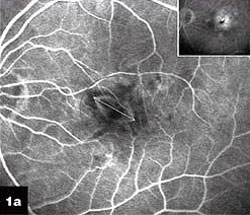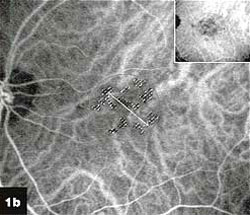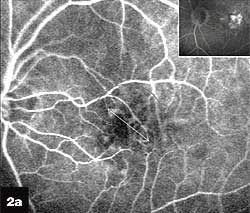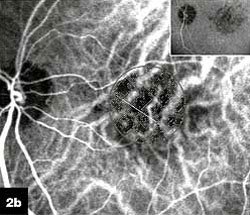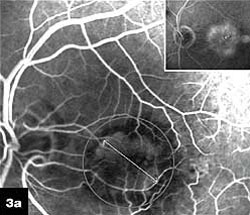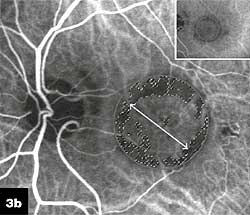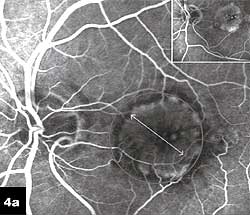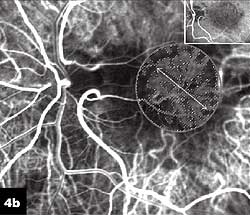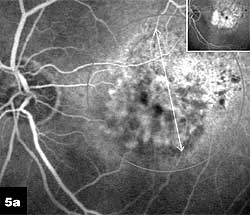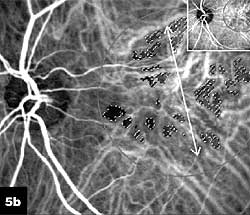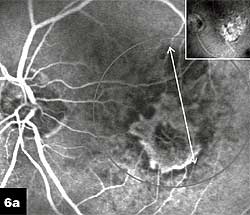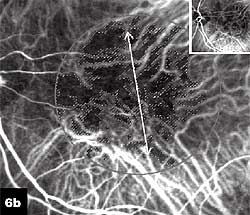Effects of PDT on choroidal vessel perfusion visible on SLO
Reduced perfusion of normal choroidal vessels was observed in about a third of eyes after multiple photodynamic therapy sessions.
Multiple sessions of photodynamic therapy for choroidal neovascularization in patients with age-related macular degeneration can result in choroidal changes in the area surrounding the treatment, according to one clinician.
"Areas of hypofluorescence due to choroidal hypoperfusion in the region surrounding the treatment were documented by indocyanine green scanning laser ophthalmoscopy (ICG/SLO)," said Florence Coscas, MD, of Créteil University Eye Clinic.
Overview
In 30 patients treated with three or more sessions of PDT, the perfusion of both choroidal neovascularization in the treatment area and the surrounding normal choroidal vessels was observed by ICG/SLO. Visual acuity was also evaluated to assess the efficacy of the treatment.
The mean age of the patients was 72 years, with a range of 59 to 88 years. The mean follow-up was 15 months (range: 15 to 30 months).
"Our results in terms of visual acuity confirmed that PDT preserves rather than restores visual acuity in most cases. In 60% of the eyes, pretreatment VA was stabilized; in 5% of the eyes it improved by more than two lines; and in 35% of the eyes it decreased by two or more lines. ICG/SLO showed a significant reduction of lesion size and leakage, although a partial persistence of CNV perfusion was present in 45% of the eyes," she said.
The effects of PDT were also seen beyond the treatment area, affecting the normal choroidal network. Reduced perfusion of normal choroidal vessels was observed in 31% of the eyes, and in 38% of the cases areas of nonperfusion were detected over more than half of the photosensitized area.
Imaging specifics
In one patient, visible subfoveal choroidal neovascularization was present before treatment, Dr. Coscas said. Visual acuity was 20/63. In the fluorescein angiography image shown in Figure 1a, the larger diameter of the neovascular membrane is marked by the yellow arrow. The red circle traces the limits of the PDT treatment area, which is always larger than the lesion, she said. The inset in the right hand corner shows the image at 5 minutes and confirms the presence of active new vessels and leakage.
In the ICG/SLO image (Figure 1b), the entire network of CNV and areas of nonperfusion (gray areas inside dotted lines) before treatment are visible. At 10 minutes, the overall extension and topography of the neovascular membrane, which is not always entirely visible on ICG angiography, is even more apparent (Figure 1b, inset), Dr. Coscas pointed out.
Two years later, and after three PDT treatments, lesion size was reduced (compared to the initial spot size marked in red) and the patient had gained about one line of visual acuity (20/50), Dr. Coscas said (Figure 2a). The ICG image at 5 minutes showed increased areas of nonperfusion, she said (Figure 2b).
"Areas of nonperfusion were not only present inside the selected treatment region, but also outside of it. Compared to pretreatment images, this was an entirely new situation," she said.
A second example showed a larger subfoveal choroidal neovascular membrane on angiography (Figure 3a) and ICG/SLO (Figure 3b), where areas of nonperfusion all round the internal limits of the membrane were marked.
Following three PDT treatments, at 18 months CNV had grown within the treatment area (Figure 4a). ICG/SLO clearly showed new vessel perfusion, and the patient had lost visual acuity lines, Dr. Coscas said (Figure 4b).
"In addition, by ICG/SLO a large area of nonperfusion was visible both inside and outside the treatment region," she noted.
A third example showed a form of mixed CNV before and after PDT treatment (Figures 5a and 5b).
"Before treatment, very few areas of nonperfusion were visible. After PDT, at 24 months, fluorescein angiography showed presence of neovascular fibrosis and absence of leakage. A large area of nonperfusion was visible inside and beyond the limits of the original lesion," Dr. Coscas said (Figures 6a and 6b).
"Multiple sessions of PDT with verteporfin for persistent or recurrent CNV are effective in stabilizing age-related macular degeneration," Dr. Coscas said.
"Leakage is significantly reduced and a complicated, exudative AMD may be replaced by a dry form with a flat macula. However, the normal choroidal vessels are affected by the treatment, and a fairly long time for recovery might be required," Dr. Coscas said.
|
|
Case 1 before photodynamic therapy; (1a) Fluorescein angiography (FA) at 81 seconds and 5 minutes (inset); (1b) Indocyanine green scanning laser ophthalmoscopy (ICG/SLO) at 5 minutes and 10 minutes (inset). |
|
|
|
Case 1 at 24 months after three PDT sessions; (2a) FA at 53 seconds and 5 minutes (inset); (2b) ICG/SLO at 5 minutes and 30 minutes (inset). |
|
|
|
Case 2 before PDT; (3a) FA at 48 seconds and 5 minutes (inset); (3b) ICG/SLO at 5 minutes and 30 minutes (inset). |
|
|
|
Case 2 at 18 months after three PDT sessions; (4a) FA at 63 seconds and 5 minutes (inset); (4b) ICG/SLO at 3 minutes and 30 minutes (inset). |
|
|
|
Case 3 before PDT; (5a) FA at 1 minute and 5 minutes (inset); (5b) ICG/SLO at 5 minutes and 30 minutes (inset). |
|
|
|
Case 3 at 24 months after three PDT sessions; (6a) FA at 68 seconds and 5 minutes (inset); (6b) ICG/SLO at 5 minutes and 30 minutes (inset). |
|
For Your Information:
- Florence Coscas, MD, can be reached at 113 bd Saint Germain, 75006 Paris, France; +33-143295659; fax: +33-143291456; e-mail: flcs@club-internet.fr.
- Michela Cimberle is an OSN Correspondent based in Asolo, Italy.

